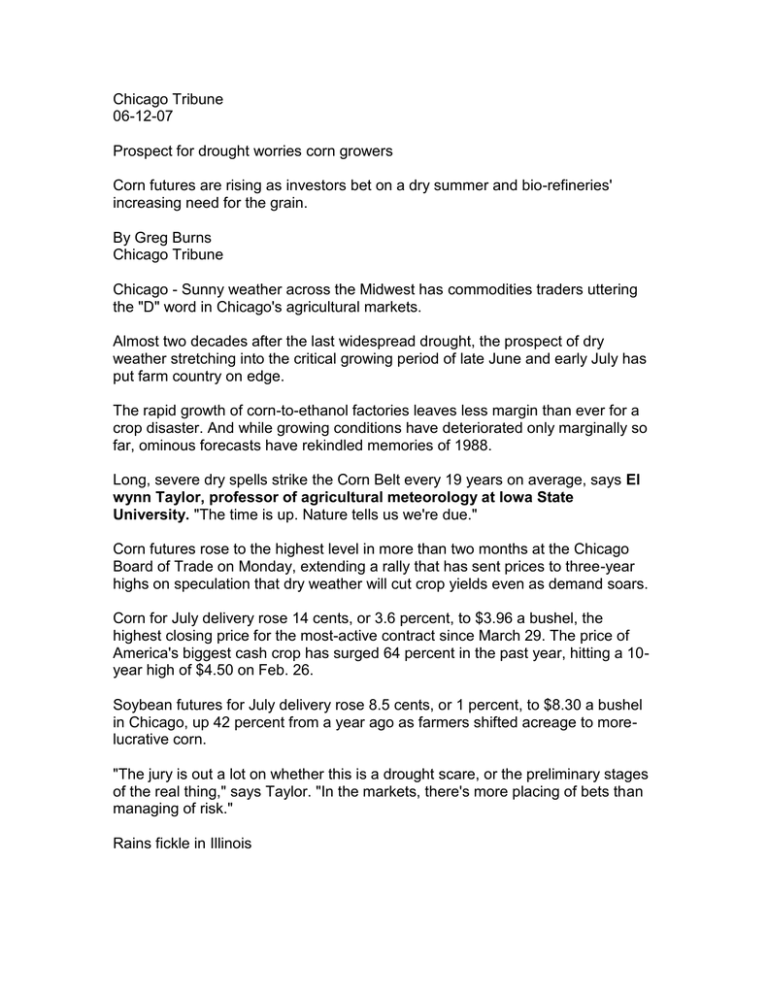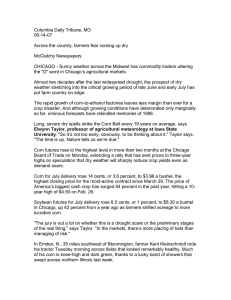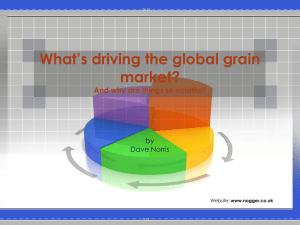Chicago Tribune 06-12-07 Prospect for drought worries corn growers
advertisement

Chicago Tribune 06-12-07 Prospect for drought worries corn growers Corn futures are rising as investors bet on a dry summer and bio-refineries' increasing need for the grain. By Greg Burns Chicago Tribune Chicago - Sunny weather across the Midwest has commodities traders uttering the "D" word in Chicago's agricultural markets. Almost two decades after the last widespread drought, the prospect of dry weather stretching into the critical growing period of late June and early July has put farm country on edge. The rapid growth of corn-to-ethanol factories leaves less margin than ever for a crop disaster. And while growing conditions have deteriorated only marginally so far, ominous forecasts have rekindled memories of 1988. Long, severe dry spells strike the Corn Belt every 19 years on average, says El wynn Taylor, professor of agricultural meteorology at Iowa State University. "The time is up. Nature tells us we're due." Corn futures rose to the highest level in more than two months at the Chicago Board of Trade on Monday, extending a rally that has sent prices to three-year highs on speculation that dry weather will cut crop yields even as demand soars. Corn for July delivery rose 14 cents, or 3.6 percent, to $3.96 a bushel, the highest closing price for the most-active contract since March 29. The price of America's biggest cash crop has surged 64 percent in the past year, hitting a 10year high of $4.50 on Feb. 26. Soybean futures for July delivery rose 8.5 cents, or 1 percent, to $8.30 a bushel in Chicago, up 42 percent from a year ago as farmers shifted acreage to morelucrative corn. "The jury is out a lot on whether this is a drought scare, or the preliminary stages of the real thing," says Taylor. "In the markets, there's more placing of bets than managing of risk." Rains fickle in Illinois In Emden, Ill., 35 miles southwest of Bloomington, farmer Kent Kleinschmidt rode his tractor across fields that looked remarkably healthy. Much of his corn is kneehigh and dark green, thanks to a band of showers that swept across northern Illinois last week. "We were fortunate to be under one, and we caught a half-inch to an inch," says Kleinschmidt, who farms about 1,000 acres. "When you play the weather game, there's the haves and the have-nots." Meantime, about 100 miles to the southeast in Tuscola, Ill., farmer Bryan Fogerson drove his tractor Monday over cracked, powdery topsoil. The light-green leaves of his corn crop were rolling up in the heat of the day, a defense the plants more commonly employ at the peak of the summer later in the year. "Things are definitely too dry, and it's definitely starting to show it," observes Fogerson, who farms 2,000 acres. A soaking rain could make up for the damage. At 3-5 feet below the surface, soil moisture levels have yet to deteriorate. And with the most acres planted in corn since 1944, the potential remains for an enormous harvest. Meteorologist Drew Lerner can't say if the Midwest is facing "a big, bad drought," but he feels confident that farmers "will be fighting dryness for the next several weeks for sure." All the signs point to that, he says, from sunspots and airflow patterns to surface temperatures in the Atlantic and Pacific. There's time for a turnaround Still, conditions have not passed the "point of no return," says Lerner, president of World Weather Inc. in Kansas. "If we get timely rains and seasonal temperatures for the rest of the summer, the crop will be just fine. Any rain in the next week or week after would be a million-dollar rain. It could turn around the crop substantially." A big crop is needed to meet the new demands of the booming ethanol industry, which has expanded in recent years to encompass 119 bio-refineries. Some 77 more are under construction, and another eight undergoing expansion, according to the Renewable Fuel Association trade group. And while research proceeds on alternative raw materials such as switchgrass, the vast majority of those operations will depend on corn. Once new plants come on line, practically nothing will stop them, says Wallace Tyner, agricultural economist at Purdue University. The combined impact of a generous federal subsidy and high oil prices means that even if a bushel of corn soared to $5.50, the typical plant still could break even from a cash-flow standpoint, he says. "We've got a long way to go before they can't cover their costs." The same is not true of livestock producers in the U.S. and abroad, who would be compelled to cull their herds if feed became so expensive, Tyner notes. Those cutbacks ultimately would lead to higher prices for meat in the grocery store. "The market will do the rationing," he says.





